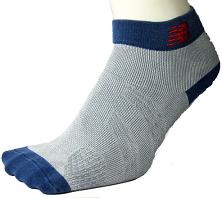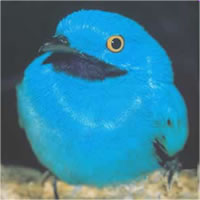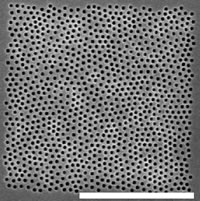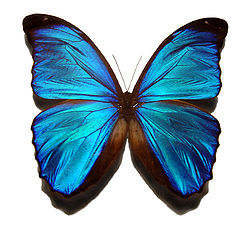The Sept. 29, 2011 news item on Nanowerk announces,
Nanotech Security Corp. has reached a major milestone in authentication and anti-counterfeiting security technology developed by replicating nano-scale structures similar to those found on the wings of the iridescent Morpho Butterfly.
Nanotech Security Corp. is pleased to announce its team of researchers have successfully created the world’s first master shim http://www.nanosecurity.ca/press_imagesvideos.php [Note: I was not able to access this site when I tried Sept. 29, 2011, 3:14 pm PST.], or master die, that manufacturers can use to reproduce nano-holes in a variety of materials – including banknotes – in large volumes quickly and cost-effectively without changing the manufacturing process.
Nanotech brings the next generation of authentication technology
“Proving that our technology can be re-created successfully with the use of a master shim was a crucial step in making it available for commercial use to our potential partners,” said Doug Blakeway, CEO and chairman of Nanotech Security Corp.
“This milestone makes our technology accessible and affordable to banknote manufacturers, while allowing them to maintain the highest level of security they require.”
I posted about NanoTech Security Corp earlier this year (January 17, 2011) when the research team who are affiliated with Simon Fraser University (SFU) were in the process of publicizing their work. This is exciting news and I hope do they well. At the same time, I am somewhat puzzled as there are a number of inconsistencies starting with the company’s age.
From the Nanotech Security Corp home page,
NANOTECH Security Corp. has a 20 year history
designing and selling security devices. Devices include
security threads for bank notes and high value documents, communication surveillance and intelligence gathering equipment for the International Defense and Law Enforcement markets.
The news item on Nanowerk states this,
With a rich history in law enforcement and security applications, Nanotech Security Corporation has embarked on a new venture bringing world class nanotechnology from Simon Fraser University to the authentication and anti-counterfeiting market.
Founded in 1985, Nanotech Security has evolved substantially, successfully implementing devices and technology in areas of criminal justice, infrared night-viewing, tracking security and forensics.
The company would be 26 years old if it were founded in 1985. The more digging I do the more confusing it gets. According to the information about NanoTech Security (NTS) Corp listed on the Toronto Stock Exhange’s Infoventure page, the company was incorporated in May 1984 (which would make it 27 years old). [ETA Oct. 3, 2011: It’s highly unlikely the company was called NanoTech Security Corp in 1984 or 1981. Was it called something else? There is no company history on the website to clarify.] NTS has two other companies as subsidiaries (?), Strategic Technologies (address and phone no. identical to NanoTech Security Corp’s listing on its website) and Tactical Technologies in Pennsylvania. [ETA Oct. 3, 2011: Tactical Technologies was formed in 1994]
The NTS website lists Tactical Technologies in its Products category (another oddity),
Tactical Technologies Inc., is a wholly owned subsidiary of NanoTech Security Corp.
Tactical is engaged in the design, manufacture and supply of sophisticated communications, surveillance, intelligence gathering and forensic equipment for the Law Enforcement and Defense Industries. Tactical works closely with its customer base and has pioneered many unique products and system solutions which surpass the needs of top security, investigative, enforcement, defense and offender detention professionals. Tactical’s core products consist of covert body worn audio transmitters, repeaters, and intelligence kits which include receivers and recording capabilities. Recently one these products, the Citation V, was featured last March in an episode of CSI: Miami. Other products include custom built surveillance vehicles, mobile/portable surveillance platforms; Cellular/IP based video surveillance systems, agent alert alarm transmitters, and other video surveillance systems. Tactical’s operations are located in Holmes, Pennsylvania; about five miles west of Philadelphia.
www.tti-narctech.com
There’s actually more information about Tactical Technologies’ products on the NSI website than there is on its own company website,
Under the laws of the United States of America,
the dissemination of product information for goods
manufactured by Tactical Technologies Inc. is restricted.
I did finally find the NTS management team page (which includes the two SFU scientists [Bozena Kaminska and Clint Landrock] whose work provides the platform for this company’s products) on the NTS website in the Press Room area [Note Oct. 3, 2011: Stylistic and grammatical changes made]. The description for Doug Blakeway, Chief Executive Officer and Chairman, provides this information,
Mr. Blakeway is Chairman and CEO of Nanotech Security Corp. (formerly Wireless2 Technologies Inc.), a publicly traded international high level public security corporation which he founded in 1985 and Managing Director for G4S Justice Services (Canada) Inc. [emphases mine] Mr. Blakeway has extensive connections in the security and policing sectors. As an entrepreneur and investor, over the past 40 years, he has founded and operated a number of successful endeavors from service oriented companies to high technology electronic manufacturing. Mr. Blakeway is a proven inventor with a variety of diverse patents for such things as a rotary engine; a portable diamond drill feed, a fluid management system, GPS asset and personnel tracking systems and an infrared night viewing system. As a helicopter pilot, his vision and tenacity resulted in the founding of WM Aviation Inc. – the parent company of Helijet Airways, the first regional helicopter service in B.C. He is presently an entrepreneur in Residence at Simon Fraser University, Venture Connection. He mentors companies and individuals and is a member of the BC Angle Form and an investor in early stage companies. Since 1982, Mr. Blakeway has been a director of a number of public companies on the TSX & Venture Exchange. He is currently a member of the board of directors of Nanotech Security Corp., IDIT Technologies Corp., IDME Development Corp., Legend Power Systems Inc, Tactical Technologies Inc, Wireless Industry Partnership Connector Inc. (WIP), and RFind Systems, Inc. Mr. Blakeway serves on audit, compensation and corporate governance committees and with his knowledge of the policies and procedures for listing Capital Pool Companies (CPC’s) has facilitated the successful qualification of a CPC to a Tier 2 issuer on the TSX Venture Exchange. Mr. Blakeway is a past member of member of British Columbia Securities Policy Advisory Committee (SPAC), and member of Simon Fraser University Surrey – Business Advisory Council, Canadian Listed Company Association, The Digital Media and Wireless Association of BC (DigiBC), Wavefront Wireless Innovation Society of BC and The Executive Committee (TEC), an international organization for CEOs.
The reference to Wireless2 Technologies could explain [Note Oct. 3, 2011: This was originally worded as “certainly explains”] why the company can claim a history of 20 years or more and I expect they are using the association with Tactical Technologies as reason to claim experience in security, surveillance, etc. I was not able to find much information about Wireless2 Technologies.
As well, I’m not clear as to the relationship that Strategic Technologies has with anything and I can’t find much information about it either. Further, I was not able to find mention of Mr. Blakeway on the G4S (Canada) website. Here’s the company history,
G4S Secure Solutions (Canada) Ltd. was founded in October 1966 by retired members of the Royal Canadian Mounted Police as Canadian Protection Services (CPS).
A recently expanded service offering, which includes all critical areas of the security industry, our Secure Solutions team has nearly 8,000 employees across the country. We operate in many different markets from Government to Private Energy & Utilities, Condominiums & Residential to Transport & Logistics, Major Corporations to Financial Institutions, Petrochemical to Natural Resources, and Healthcare to Retail & Loss Prevention.
In early 2000, G4S Cash Solutions (Canada) Ltd. entered the Canadian market as Securicor, with the purchase of a number of cash services providers. Through these acquisitions, G4S Cash Solutions gained over 71 years of experience of the Canadian cash services market.
In 2005, expansion continued with the acquisition of Ontario’s largest regional service provider, a move that further ingrained the business in the nation’s largest market. With over 2,500 employees and 55 branches across the country, G4S Cash Solutions continues to operate the largest, market leading coast-to-coast service network in Canada.
As a result of the 2004 merger between Group 4 Falck A/S and Securicor plc, two Canadian security service divisions were united in Canada under a global brand.
With over 10,000 employees across the nation, G4S brings a wealth of security knowledge and expertise to the Canadian marketplace.
In Canada, our complete focus as security experts is to provide innovative and quality security solutions to businesses across the country.
I cannot find a reference to G4S Justice Services (Canada) other than listings in the Yellow Pages, CanPages, and the like. G4S is an international company which was founded in 1901 in Denmark. Its headquarters are currently located in the UK. The Canadian subsidiary is in fact two entities G4S Secure Solutions (Canada) and G4S Case Solutions (Canada). Mr. Blakeway is not included on the website as a member of either management team. As I noted it’s all rather puzzling but that may be due to my ignorance of business structures.
It’s early days yet for NTS and I imagine this is the ‘growing pains’ part of the process and that these inconsistencies will be rectified and, perhaps, some of the more ‘hyped’ terminology regarding the products and the attempts to fuse the company name with the entire field of nanotechnology will be toned down.







